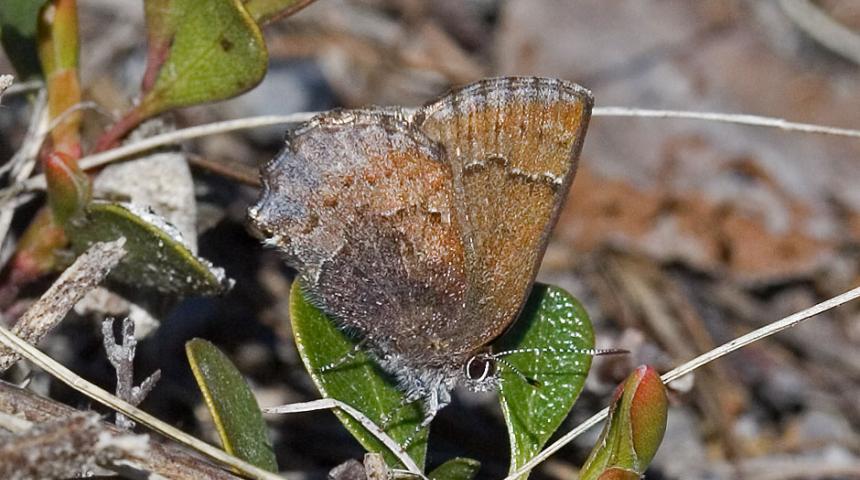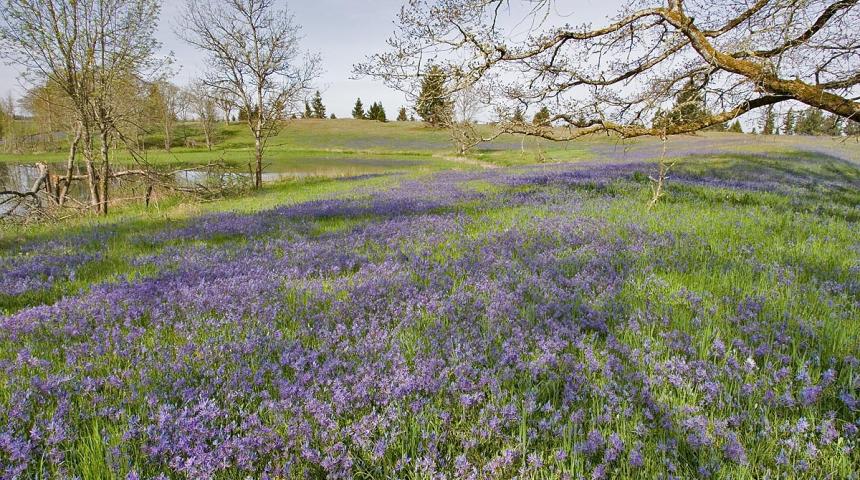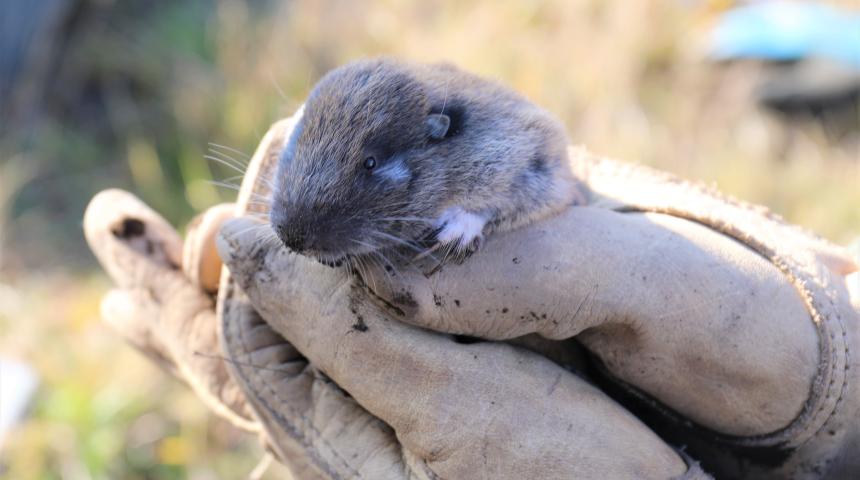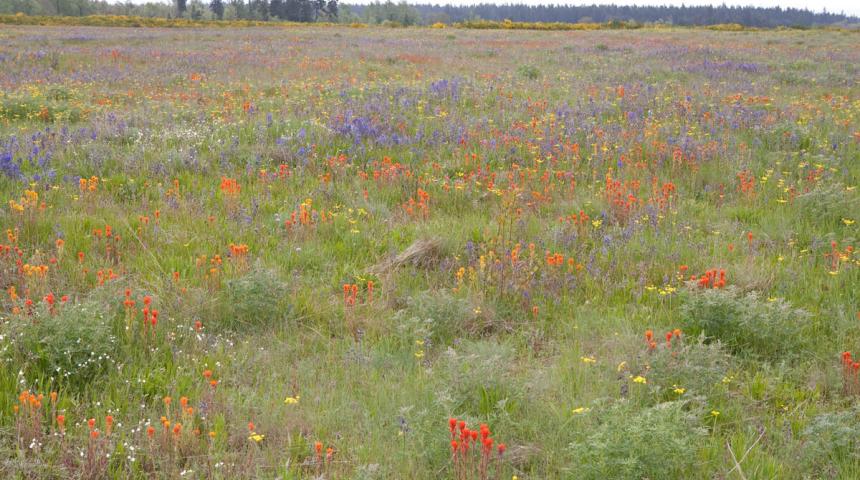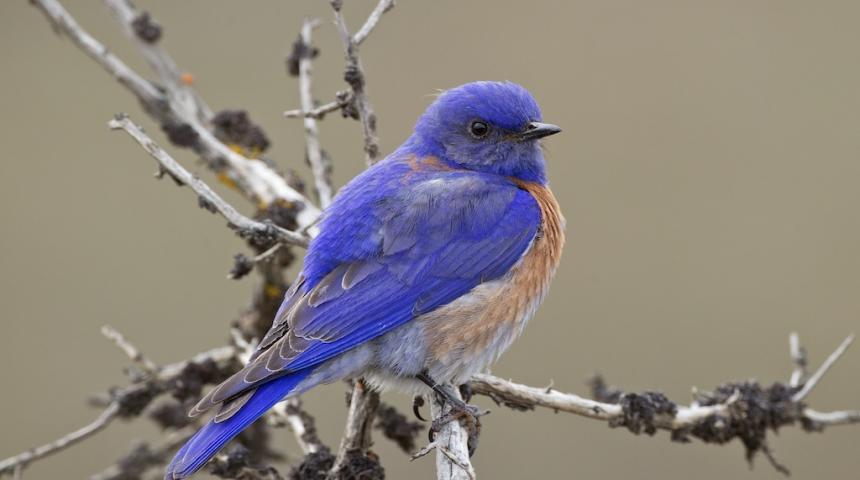Prairies are one of the rarest ecosystems in Washington. Once common in the South Puget Sound region, habitats such as prairies and oak woodlands are now almost gone, with just 3% of original prairies remaining. They were created by glaciers 15,000 years ago which left behind gravelly soils. Prairie vegetation is dominated by a variety of grasses and wildflowers with few trees.
Prior to settlement by non-indigenous people in Washington, prairie habitat covered an estimated 180,000 acres of Western Washington. In the ensuing years, large areas of prairie were converted to farmland and development. Most of that prairie is now gone and much of what is left is degraded.
Prairies support a variety of plants and animals – some of which are listed as threatened or endangered under the federal Endangered Species Act. This rare ecosystem is home to many of Washington’s most imperiled species, and is one of WDFW’s highest conservation priorities.
Description and range
Physical description
Prairies in Washington are open native grasslands with little or no tree cover. Prairies have flat, rolling, or gentle slopes and are adapted to moist winters and dry summers. Typically located on well-drained glacial soils, this fire-adapted system historically was maintained by indigenous peoples who intentionally burned prairie to prevent invading trees and shrubs, increase the growth of food plants such as camas, and improve habitat for game species. Without fire, woody plants often invade and crowd out the native grasses and flowering plants that make up this ecosystem.
There are two prairie ecosystems in Western Washington: 1) dry, upland prairie, and 2) wet prairie. The more common upland prairie occurs on deep, gravelly, well-drained glacial soils in bottomlands, along valley margins, and in lower foothills. Wet prairie occurs on clay-rich soils that are saturated to the surface during the early part of the growing season. These areas then gradually dry out during the summer. Wet prairies in Puget Sound are usually found on glacial outwash soils in swales or low-gradient riparian areas.
Geographic range
Prairie ecosystems extend from Oregon's Willamette Valley through Washington's Puget Sound regional all the way north into the Georgia Basin region of southern British Columbia. In Washington, prairies are mostly found in the South Puget Sound, but are also seen as far north as the San Juan Islands and as far south as Clark County.
Species
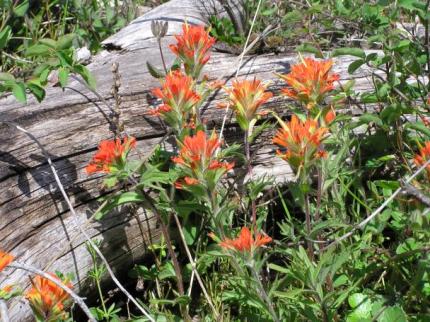
Areas of native grasslands have drastically declined in Western Washington as the climate shifted from a post-glacial dry period to the moister conditions of today which favor forests. The South Puget Sound area historically had extensive prairies on glacial outwash plains with flat or small-hilled topography (called Mima mounds (PDF)) originating about 12,000 years ago from the retreat of the Vashon glacier. The plants and animals associated with today’s South Puget Sound prairies may have become established between 5,000 to 10,000 years ago when the climate was warmer and drier.
Westside prairies formed during the dry period were maintained by annual soil drought which prevented tree growth and caused frequent fires. Historically, prairie environments varied depending on hydrology, soil depth and rockiness, and fire history – from sites with lush grass and wildflowers, to sites with little vegetation and abundant mosses and lichens. In addition, oak savannas – scattered oak trees with a grassland understory – which were once common, are now rare.
The geology and topography of westside prairies create specific site characteristics that some wildlife can use as refuge during extreme weather. For example, rocky soils may provide the sparse vegetation desired for nesting by streaked horned larks (Eremophila alpestris strigata). Prairie topography also provides a range of microclimates that help butterfly populations survive a wider range of weather.
Prairies were economically important to some local tribes, and many prairie plants were used as food or medicine. The Cowlitz people have been called a “prairie people,” as their economy depended on prairie productivity. The Coast Salish people periodically burned prairies to encourage growth of food and medicine plants. Routine burning may have increased the coverage of broadleaf plants (forbs) versus grasses in parts of the pre-European landscape. Food plants included bracken fern and forbs like common camas and strawberry, as well as shrubs like serviceberry and blackberry.
Over the last 150 years, prairies have rapidly disappeared as Euro-American agriculture spread and development expanded. As the prairies have declined, so have many plant and animal species, including some distinct subspecies found nowhere else in the world. Some animals already seem to be extinct in Western Washington such as the Pacific gopher snake (Pituophis catenifer catenifer).
Plants
Dry, upland prairie vegetation consists of low growing native grasses and forbs. Native prairie grasses include Idaho fescue, California oatgrass, blue wildrye, and junegrass. Showy, slow-growing forbs native to westside prairies include common woolly sunflower, rose checker-mallow (PDF), common camas, and golden paintbrush. Golden paintbrush is listed as threatened under the federal Endangered Species Act. Annual summer drought historically suppresses tree growth, although Oregon white oak and Douglas-fir are often found scattered in prairies and eventually become fire resistant. Although a native tree, encroachment by Douglas-fir on prairies can shade out prairie plants.
Wet prairie occurs on poorly drained soils that support wetland-associated plants. Wet prairie ecosystems are less common and more imperiled than dry, upland prairie. This ecosystem is seasonally wet, often flooding between November and April. Soils then dry out in the summer months. Native wet prairie is dominated by low-growing herbaceous plants that include a variety wetland-associated sedges and forbs.
Unfortunately, invasive plants mixing with native species have degraded and dominate all remaining upland prairie in Western Washington. Although the prairie ecosystem looks much different than it did historically due to the abundance of invasive plants, this habitat still has huge value to Washington’s wildlife.
Wildlife
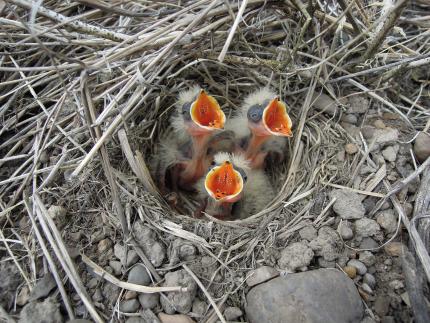
Some prairie wildlife species have been genetically isolated for so long that unique forms have evolved. These unique forms have become rare along with their habitat, and some are threatened with extinction. South Puget Sound prairies are home to several of these species, including Mazama pocket gopher, streaked horned lark, and Taylor's checkerspot butterfly.
Species of Greatest Conservation Need
Species of Greatest Conservation Need (PDF) include species that are state listed as sensitive, threatened, or endangered, or federal listed as threatened or endangered, as well as additional species thought to need conservation attention. These species of greatest conservation need are the basis for the State Wildlife Action Plan, which is an effort to protect rare species while keeping common species common.
The plan links species of greatest conservation need to the specific habitats they depend on. To not only survive but thrive, these species require quality habitats.
The following list features Species of Greatest Conservation Need that depend on prairie habitats.
Birds
Butterflies
- Dog star skipper
- Hoary elfin
- Island marble*
- Mardon skipper*
- Oregon branded skipper (Salish Sea segregate)
- Propertius duskywing
- Puget blue
- Puget Sound fritillary
- Taylor's checkerspot*
- Valley silverspot
Mammals
Reptiles
* Indicates "at-risk" species, meaning the animal is state listed as sensitive, threatened, or endangered, or is federal listed as threatened or endangered.
At-risk wildlife
"At-risk" species include animals that are listed as sensitive, threatened, or endangered at the state or federal level. The following section highlights at-risk species that rely on westside prairie habitats at some point during their lives.
Mazama pocket gopher (Thomomys mazama)
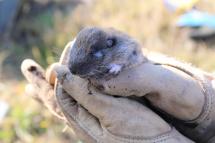
In Washington, the Mazama pocket gopher is only found west of the Cascades. All subspecies of the Mazama pocket gopher are state listed as threatened; four subspecies are federally listed as threatened (Roy Prairie, Olympia, Tenino, and Yelm subspecies), occurring only in Thurston and Pierce counties. Some subspecies are threatened by habitat loss from human development. Mazama pocket gophers can tolerate some levels of development, but high-density development can cause local extinction of a subspecies. Historically, the species was widespread on South Puget Sound prairies, but was reduced by habitat loss due to development, agriculture, and succession or planting of trees and shrubs.
Pocket gophers are the only truly subterranean rodents in North America and are rarely observed above ground, spending most of their time within their system of burrows.
Did you know?
- Except during breeding season, Mazama pocket gophers are mostly solitary and exclude other gophers from their burrows.
- Food caches and latrines of these “ecosystem engineers” enrich the soil, influencing plant community and productivity.
- Gopher burrows provide retreats for salamanders, frogs, lizards, small mammals, and invertebrates.
Learn more about the Mazama pocket gopher.
Oregon vesper sparrow (Pooecetes gramineus affinis)
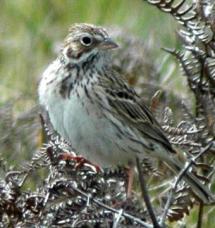
The Oregon vesper sparrow is state listed as endangered in Washington. This bird is a subspecies of vesper sparrow. It has a restricted breeding range that includes southwestern British Columbia, Western Washington, Western Oregon, and northwestern California. Oregon vesper sparrows are seen in Western Washington from early April through late September. They migrate to central and southern California for the winter. This subspecies is mainly found in prairie habitats in Pierce and Thurston counties, with smaller numbers on islands in the lower Columbia River and on San Juan Island. A few may still breed in eastern Clallam County and near Shelton in Mason County.
This subspecies is in danger of becoming extinct in Washington due to habitat loss and degradation, as well as unpredictable ecological events like fire, flooding, and disturbances during their nesting season.
Did you know?
- Oregon vesper sparrows eat seeds and insects they find on the ground.
- These sparrows use grass and tiny roots to build nests on the ground, often near the base of a weed or shrub.
- The Oregon vesper sparrow is the rarest of four recognized subspecies of vesper sparrow.
Learn more about the Oregon vesper sparrow.
Streaked horned lark (Eremophila alpestris strigata)
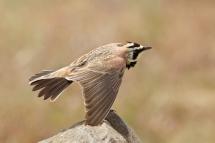
Streaked horned larks are federally listed as threatened and state listed as endangered. They are found on prairie habitat south of Puget Sound, coastal beaches, and dredge spoil islands along the lower Columbia River. Primary concerns for this species are habitat loss and degradation as well as human-activities such as mowing grass at breeding sites.
This subspecies of horned lark is a focus of WDFW’s conservation efforts with partners such as Joint Base Lewis-McChord, Center for Natural Lands Management, U.S. Army Corps of Engineers, civilian airports, Oregon State University, U.S. Fish and Wildlife Service, American Bird Conservancy, Port of Portland, and The Evergreen State College.
Did you know?
- The “horns” on the lark’s head are actually tufts of feathers.
- The streaked horned lark occasionally breeds on airport grasslands.
- Horned lark chicks are mostly independent at four weeks old.
Learn more about the streaked horned lark.
Island marble butterfly (Euchloe ausonides)
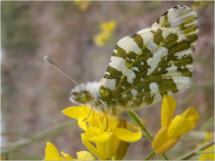
The Island marble is a rare butterfly, believed to be restricted to two San Juan Islands. In 2020, this species became federally listed as endangered. Thought to be extinct since 1908, the butterfly was re-discovered by biologists during a prairie survey in San Juan Island National Historical Park in 1998. It was also found a few years later on Lopez Island but has not been seen since 2006. The entire population exists on the south end of San Juan Island.
The island marble inhabits open grasslands, disturbed sites, and herbaceous or sparsely vegetated habitats such as native prairie, pastures, sand dunes, gravel pits, and marine beaches where their annual host plants grow.
Did you know?
- After emerging from its chrysalis stage, adult females will mate, lay their eggs on mustard species flowers (host plants), and then die.
- After hatching, caterpillars (larvae) of this species eat mustard flowers and seed pods before leaving their host plant.
- This species spends about 300 days of its year-long life cycle as a chrysalis waiting for the right environmental cues to undergo metamorphosis and emerge as a butterfly.
Learn more about the Island marble butterfly.
Mardon skipper butterfly (Polites mardon)
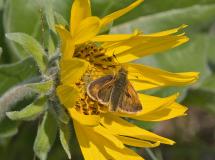
In Washington, the Mardon skipper is state listed as endangered, and their population size is low and declining. This skipper is now only found at four small, geographically separated areas in Washington, Oregon, and California. It is one of five butterflies in the skipper family recognized as Species of Greatest Conservation Need (PDF) throughout their ranges due to the small number of isolated populations, specialized and restricted habitat, and known habitat threats. Research is needed to more accurately quantify specific habitat requirements including the makeup of their preferred vegetation and favored nectar plants.
The Mardon skipper inhabits glacial outwash prairies in South Puget Sound and montane meadows at 1,800 to 5,500 feet in elevation in the southeastern Cascade Mountains. Glacial outwash prairies in Western Washington have been reduced to less than 3% of historical cover.
Did you know?
- Mardon skipper caterpillars (larvae) create silken shelters to conceal themselves in selected grasses where they overwinter.
- As butterflies, they use their long proboscis to sip nectar from flowers such as early blue violet and common vetch.
- They are non-migratory and sedentary, moving less than 1,000 feet from where they hatch.
Learn more about the Mardon skipper butterfly.
Taylor’s checkerspot butterfly (Euphydryas editha taylori)
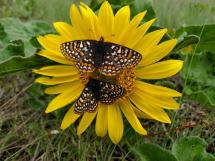
Taylor’s checkerspot is federally and state listed as endangered. It is a Pacific Northwest native (endemic) butterfly. It was historically found in open prairie and grassland habitats from southeastern Vancouver Island, British Columbia, south through the Puget Sound region of Western Washington, and into the southern Willamette Valley of Oregon. In addition to prairies, it also occupies coastal bluffs and dunes as well as small forest openings. The species is currently restricted to a scattering of eight populations in Washington, one population in British Columbia, and two populations in Oregon.
The decline of this butterfly has accompanied the loss of its habitats. Since 2006, habitat enhancement for Taylor's checkerspot has become a focus of conservation efforts. Continued effort is greatly needed to reconnect this butterfly’s fragmented and isolated habitat.
Did you know?
- In spring, females lay eggs on specific plants that serve as food for emerging caterpillars (larvae).
- Caterpillars enter a suspended state of development (diapause) from early summer to late winter.
- Local zoos and the Sustainability in Prisons Project have been instrumental in breeding caterpillars for release at suitable sites to help with species recovery.
Learn more about the Taylor’s checkerspot butterfly.
Western pond turtle (Actinemys marmorata)
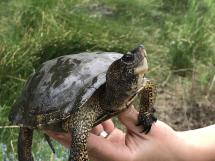
In Washington, the western pond turtle is state listed as endangered. It prefers open upland habitats with extensive sun exposure such as Puget Sound prairies, pastures, and oak-pine savanna and other open forest types in the Columbia River Gorge. The turtles disappeared from the Puget lowlands by the 1980s, with only a few isolated adult turtles remaining. Due to recovery efforts, there are now six populations in Washington: two in south Puget Sound and four in the Columbia River Gorge.
Western pond turtles face many challenges. Their habitat must be managed to prevent invasive weeds from overgrowing nesting areas. Non-native American bullfrogs and various mammals prey upon their hatchlings and nests, which prevents natural population growth. Ulcerative shell disease (PDF) – a disease that damages the shell and leads to infection – has recently become a major concern. The Sustainability in Prisons Program and other partners help rehabilitate Western pond turtles with signs of ulcerative shell disease for release back into the wild.
Did you know?
- Western pond turtles lay eggs that are adapted to dry nesting conditions.
- The turtles bask on logs in ponds and lakes to raise their body temperature, which helps with food digestion.
- Warming temperatures on nest sites, influenced by climate change, may increase the number of female offspring.
Places to explore
Washington’s wildlife areas provide habitat for fish and wildlife as well as land for outdoor recreation. Each year, thousands of people visit these areas to hunt, camp, hike, fish, and enjoy other outdoor activities. These activities support local economies and contribute to Washington’s wildlife-related recreation industry.
WDFW owns or manages nearly a million acres of land on 33 wildlife areas across the state. In addition to wildlife areas, WDFW also owns or manages hundreds of water access areas that provide boating or fishing access to lakes, rivers, and marine areas.
All visitors to WDFW lands need to display a current Discover Pass or WDFW Vehicle Access Pass. Annual and daily Discover Passes are available online at fishhunt.dfw.wa.gov or at license vendors across the state. Vehicle Access Passes are free with the purchase of most Washington hunting or fishing licenses.
Wildlife area unit
- South Puget Sound Wildlife Area Unit
The South Puget Sound Unit, within the city limits of Lakewood, is home to the Urban Wildlife Interpretive Center and the Lakewood Fish Hatchery. A paved trail offers opportunities for walking and is accessible for persons with disabilities. The unit is one of the last remnants of South Puget Sound prairie ecosystem that once stretched across thousands of acres in the region.
- Scatter Creek Wildlife Area Unit
The Scatter Creek Unit contains the unique south Puget Sound prairie ecosystem, which supports a variety of imperiled plant and animal species. Riparian and forest habitats are found here, including an Oregon white oak community that is uncommon on the west side of the Cascade Mountains.
- West Rocky Prairie Wildlife Area Unit
Popular recreational activities on the West Rocky Prairie Unit include wildlife viewing, hunting, and botanical studies. South Puget Sound prairie habitat on this unit supports a variety of imperiled plant and animal species, and includes the Mima Mounds (a geological curiosity). It also includes riparian, wetland, and forest habitats, as well as an Oregon white oak community which is relatively uncommon west of the Cascade Mountains.
- Glacial Heritage Wildlife Area Unit
The Glacial Heritage Unit is part of a larger complex of conservation and recreation lands that encompass Mima Prairie and the Black River. The unit was acquired in 2005 for the purpose of perpetuating the rare south Puget Sound prairie ecosystem that benefits many threatened and endangered species. The unit is surrounded by Thurston County conservation land and is ONLY open to the public once a year on Prairie Appreciation Day, offering a great opportunity to view wildlife and enjoy nature, along a network of maintained trails and roads surrounded by the beautiful Mima Prairie.
- Bell Creek Wildlife Area Unit
The Bell Creek Unit, east of Sequim, is ecologically diverse and includes deciduous dominant riparian forest, marsh wetland, forested wetland, wet upland meadows, and Oregon white oak-woodland prairie. The unit is managed for conservation, restoration and enhancement of these habitats. Prairie habitat supports many kinds of butterfly.
Other places to visit
- Mima Mounds Natural Area Preserve
Mima Mounds Natural Area Preserve in Thurston County has an interpretive trail system including a paved, ADA-accessible 0.5-mile loop, and two longer gravel paths to the north and south of the paved loop. The interpretive center includes informational signage about the geology, Mima mound hypotheses, prairie ecology, fire, and Native American use. Learn more about the unique geology of the Mima mounds.
- Lacamas Prairie Natural Area Preserve
The Lacamas Prairie Natural Area Preserve in Clark County protects sensitive and one-of-a-kind ecosystems and is used only for research, guided tours, and educational outings. This combined natural area preserve and natural resources conservation area protects the best known remnant of the Willamette Valley wet prairie ecosystem in Washington.
- Carrie Blake Community Park
Carrie Blake Community Park in Clallam County offers ADA-accessible walking paths, a fishing pond, dog park, and many other amenities. From the north end of the park, you can view oak-woodland prairie restoration efforts occurring on the WDFW-managed Bell Creek Unit of the North Olympic Wildlife Area.
Conservation
Westside prairie is identified as a “Priority habitat” under the Priority Habitat and Species Program. Priority habitats are habitat types or elements with unique or significant value to a diversity of species.
A priority habitat may consist of:
- A unique vegetation type such as shrubsteppe or a dominant plant species such as juniper savanna;
- A described successional stage such as old-growth forest; or
- A specific habitat feature such as cliffs.
WDFW management tools
The Priority Habitat and Species Program is the Department’s primary means of transferring fish and wildlife information from our resource experts to local governments, landowners, and others who work to protect habitat. This information is used primarily by cities and counties to implement and update land use plans and development regulations under the the Growth Management Act and Shoreline Management Act.
In the Department’s State Wildlife Action Plan “Habitats of Greatest Conservation Need (PDF)” chapter, prairie corresponds to these ecological systems of concern: Willamette Valley Upland Prairie and Savanna and Willamette Valley Wet Prairie.
The State Wildlife Action Plan is part of a nationwide effort by all 50 states and five U.S. territories to develop conservation action plans for fish, wildlife, and their natural habitats—identifying opportunities for species’ recovery before they are imperiled and more limited. A habitat of greatest conservation need is defined as an ecological system and community types that are essential to the conservation of Species of Greatest Conservation Need in Washington.
Conservation threats and actions needed
Major threats to prairie habitat
- The loss of fire as a natural disturbance: The lack of fires on westside prairies over the last 100 years has allowed Douglas fir trees to encroach, except on the driest sites. This encroachment can cause prairies and grasslands to become forests. Fire suppression has also led to increases in shrub cover and the transformation of some prairies to shrublands.
- Non-native and invasive plants: Non-native species generally increase after ground-disturbing activities. The dominant native grass, Roemer’s Fescue, and many herbaceous species are threatened by the uncontrolled spread of invasive Scotch broom. The presence of invasive grasses and forbs, in addition to Scotch broom, can complicate vegetation control and restoration efforts. Some control methods that eliminate Scotch broom, like burning, may encourage growth of pest forb and grass species such as colonial bentgrass and velvetgrass, which also degrade prairies.
- Habitat loss and fragmentation primarily caused by development: Westside prairie occurs in in one of the fastest developing regions of the state. Consequently, much of the lands that were once prairie have been lost and fragmented by the conversion to residential and commercial development.
Actions needed to maintain quality habitat
- Restore the benefits of fire in prairie ecosystems through prescribed burning
- Control invasive plant species
- Protect prairie ecosystems through acquisition, conservation easements, and landowner agreements
Conservation efforts
The Washington Department of Fish and Wildlife is involved in a variety of work to benefit westside prairie ecosystems and the species that depend on prairie habitat. Here are a few of our partnerships focused on protecting and restoring prairie ecosystems.
Scatter Creek Prairie and Oak Restoration
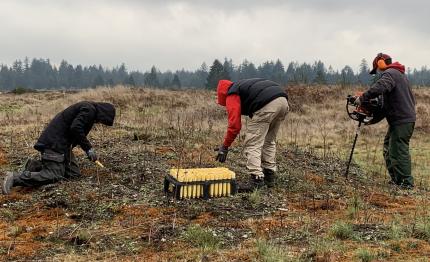
Prairie and oak restoration have been a major focus of management on the Scatter Creek Wildlife Area for over 20 years. In that time, the Department has partnered with many organizations including U.S. Fish and Wildlife Service, Center for Natural Lands Management, Capitol Land Trust, Department of Natural Resources, Recreation Conservation Office, Joint Base Lewis-McCord, and the Confederated Tribes of the Chehalis Reservation. These partners have provided resources for restoration projects such as native seeds and seed storage, native plants, restoration consultation, equipment, and staffing for both prescribed fire and other enhancement activities. Between 2009 and 2019, WDFW carried out projects to restore more than 2,000 acres on the Scatter Creek Wildlife Area.
Prairie-Oak partnerships with Joint Base Lewis-McChord
Joint Base Lewis-McCord (JBLM) is home to many habitat types that are important to fish and wildlife, including:
- The largest remaining areas of historic prairie in the region
- Garry oak woodlands (also called Oregon white oak) which are Washington’s only native oaks
- Ponderosa pine grasslands which are more commonly found east of the Cascade Mountains
The Department has partnered with JBLM on many conservation efforts like restoring and expanding prairie and oak habitat on the base. This has involved mowing, herbicide use, prescribed fire, thinning, plugging (planting small native plant starts), and seeding. The Department also partnered with JBLM to study and restore populations of prairie species like Taylor’s checkerspot, Mazama pocket gopher, and the streaked horned lark.
Sustainability in Prisons Project
The Department participates in the Sustainability in Prisons Project founded by The Evergreen State College and Washington State Department of Corrections. This program develops and delivers a wide range of science, sustainability, and environmental education programs in all 12 Washington State prisons. This includes a project to restore the federally and state endangered Taylor’s checkerspot, which is a species of butterfly that requires high-quality prairie habitat.
Watch this video from the Sustainability in Prisons Project about Taylor's checkerspot and Western pond turtle conservation.
Get involved
Volunteer
- Register as a WDFW volunteer to help with activities that benefit fish, wildlife, and habitat, including prairie and oak woodlands restoration at Scatter Creek Wildlife Area.
- Join a Volunteer Advisory Committee to participate in the Washington State Recreation and Conservation Office’s grant programs that protect prairie ecosystems.
Get involved in your community
- Provide input to your local government about development in prairie areas and its impacts to fish and wildlife species.
- For example: Take advantage of the public engagement opportunities afforded through Washington State’s land use planning frameworks, including the Growth Management Act. All towns, cities, and counties are required to protect critical areas, which include fish and wildlife habitat conservation areas.
- Contact a regional salmon enhancement group to learn about volunteer opportunities near you such as planting parties, vegetation monitoring and maintenance at restoration sites, and educational outreach at community events.
- Participate in Prairie Appreciation Day each spring to learn more about this rare ecosystem.
- Help track plant and wildlife activity on the prairie. Use iNaturalist to share your observations and help scientists see how native species are thriving.
- Get involved with the Voluntary Stewardship Program if you are an agricultural landowner, producer, or other agricultural operator, and your county participates.
- Reach out to your local habitat biologist or private lands biologist (PDF) for ideas on how to conserve, protect, and restore prairies in your area.
Support public lands
- Buy a Discover Pass for yourself or as a gift. This parking pass provides access to recreation lands managed by WDFW, Washington State Parks, and Washington Department of Natural Resources; and purchasing the pass provides funding to those agencies.
- Recreate responsibly in the great outdoors, including following “Leave No Trace” principles.
Share your prairie experience
- Share your photos and observations of prairie wildlife species to help us monitor wildlife populations and habitat.
Resources
WDFW publications and guides
- Washington State Status Report for the Mazama Pocket Gopher, Streaked Horned La…
This report summarizes what is known about the natural history and status of three species that depend on South Puget Sound prairies.
- Management Recommendations for Washington’s Priority Habitats: Oregon White Oak…
These management recommendations are designed to maintain and enhance the integrity of Oregon white oak woodlands, reverse the trend of oak habitat loss, and promote the protection of oak habitat that is presently in good condition.
- Priority Habitats and Species Management Recommendations: Mazama Pocket Gopher
These management recommendations inform local government permit reviewers, applicants, consultants, and landowners working on projects with potential impacts to Mazama pocket gopher, a state-listed threatened species.
Educational materials
- Ecosystems in Washington at-home educational resources
Learn what makes a healthy ecosystem and explore a variety of ecosystems in Washington in this collection of lessons and activities.
- Restoring prairie habitat at the Scatter Creek Wildlife Area
Learn how the Department is using fire to restore prairie habitat at the Scatter Creek Wildlife Area.
- Mima Mounds Natural Resource Area
Explore prairie habitat and the unique geology of Mima Mounds. Mima Mounds is part of Washington 100 – a tour of 100 scenic places – provided by Washington Department of Natural Resources and Washington Geological Survey.
- Guide to the Mima Mounds
Learn about the small, irregularly spaced hills covering the prairie in this illustrated booklet.
- Butterfly Guide - Mima Mounds Natural Area Preserve
Learn to identify prairie butterflies with this guide from The Nature Conservancy.
- Introducing…The Mazama Pocket Gopher
Learn about the four threatened subspecies of gophers in South Puget Sound and the prairie habitat they depend on.
- South Sound Prairies
The Center for Natural Lands Management hosts a website dedicated to South Sound Prairies that includes an abundance of information, resources, photos, and videos.
Other resources
- Scatter Creek Wildlife Area Advisory Committee
This committee guides development of the Wildlife Area Management Plan for the Scatter Creek Wildlife Area which contains prairie habitat.
- South Puget Sound Wildlife Area Advisory Committee
This committee guides development of the Wildlife Area Management Plan for the South Puget Sound Wildlife Area which contains prairie habitat.
- Practical Guidelines for Wetland Prairie Restoration in the Willamette Valley, …
The guide focuses on restoration in agricultural lands. A large percentage of historic wetland prairie lands have been converted to agricultural uses and therefore some of the greatest potential for large scale restoration exists in these areas.
- Prairie Landowner Guide for Western Washington
This handbook suggests how prairie landowners can manage their land to reduce impacts on prairies, while maintaining other uses for the land like pastures, farming, gardens, and lawns.
- Restoring Your Crop Field to Conservation Prairie
This guide shares basic steps to restore a crop field to a conservation prairie. Crop fields are an excellent “blank slate” starting point for restoring prairie. Conservation prairie is designed to mimic native prairie using a seed mix that has many different native species adapted to the restoration site. This diversity provides habitat and food for native insects, including pollinators, and wildlife.
- Restoring Your Degraded Grassland to Conservation Prairie
This guide shares basic steps to restore degraded grasslands to a conservation prairie. Grasslands that have a combination of both desired native species and invasive perennial weeds may be restored to reduce the coverage of invasive species and promote the health of the native prairie community. Conservation prairie is designed to mimic native prairie with a variety of native species that provide habitat and food for native insects, including pollinators and other wildlife.
